Pears are a great tree to grow for an edible landscape or fruit garden (Figure 1). However, pears are not adapted to all areas in Florida, and only a few cultivated varieties will grow well here. An adaptation to warm winters (low chill hours) and disease resistance are the main factors for success. According to the census of agriculture for Florida, there were at least 85 acres of pears under production in 2017, but 14 counties did not report acreage. Many plantings are just a few trees in backyards. This publication will provide information to help homeowners select and grow pears successfully in Florida.
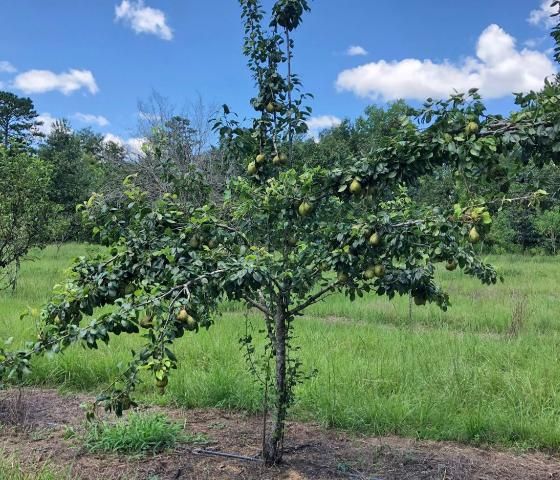
Credit: Chestnut Hill Nursery
Varieties
There are two groups of pears grown in the United States, Pyrus communis L., the European pear, and the Asian pear, P. serotina and P. pyrifolia, as well as hybrids between the two groups. Hybrid pears are suited to central and north Florida, but none are recommended south of Orlando.
Temperatures and diseases limit the varieties of pears that will grow in Florida. Temperatures of 26°F or below will usually kill open blossoms (Figure 2), so select varieties that will flower when temperatures in your area will be above this for most years (Table 1). Also, the number of chill hours in the winter (i.e., the amount of time temperatures are below 45°F) will affect which varieties will grow in your area. The information in Table 1 has been gleaned from various reports, only some of which were done by UF/IFAS. Reported research was often done in north Florida (Monticello).

Credit: UF/IFAS
Pollination
Most Florida varieties do not require cross-pollination but may have larger crops when planted with another variety. However, if Table 1 indicates that cross-pollination is required, be sure to plant another variety with a similar bloom date. Insects are still needed for pollination even if the variety can pollinate itself.
Propagation and Planting
Pears do not come true to seed and so are sold as grafted selected cultivars on suitable rootstocks (Figures 3–4). Pears grow best on well-drained, fertile, sandy loam soil, but they can be grown on a wide range of soil types. Pear trees in Florida should be grafted on Pyrus calleryana rootstocks. In a five-year study, the growth and survival of 'Flordahome' and 'Hood' were best on P. calleryana, followed by P. betulaefolia. The remaining rootstocks in the study (P. communis 'Old Home Farmingdale 51', 'Old Home Farmingdale 97', 'Old Home Farmingdale 333' and Cydonia oblonga) were unsatisfactory.
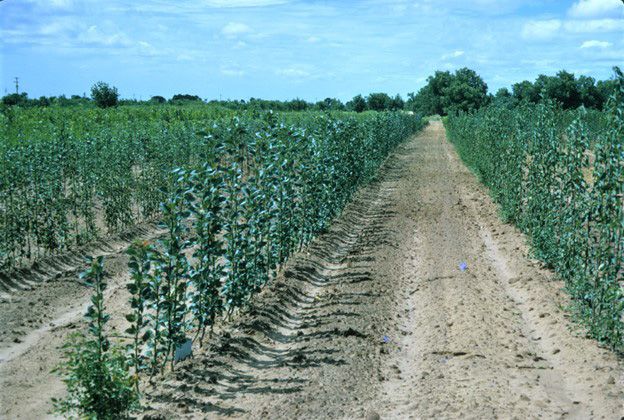
Credit: UF/IFAS

Credit: UF/IFAS
One- or two-year-old bare-root trees are best planted in late December through January to allow time for roots to establish before spring growth, but they may be planted any time during the dormant season. Container-grown trees may be planted at any time of the year if irrigation is carefully maintained.
When planting, take care not to bend or break roots to fit into the planting hole. Prune broken, damaged, or extra-long roots before planting. Dig the hole wide enough to accommodate the roots and deep enough to keep the plant at the same soil depth as found at the nursery, with the top root close to the soil line. Water in the soil around the roots as you replace it in the hole to remove air bubbles and provide good contact between the soil and the roots. Create a berm of soil around the plant that will hold several gallons of irrigation water in the root zone, and water well. Do not fertilize the trees for a month after planting to allow the roots to establish in the soil.
Cultivation
Pear tree roots are close to the surface. Maintain a weed-free area from the trunk out about two feet with hand-weeding, shallow hoeing, or mulch. Be aware that pear bark is thin, and postemergent chemical herbicides like glyphosate can be taken up through the bark to damage tree growth. Trunk wraps can protect the tree from herbicide application and mower or Weed-eater damage.
Irrigation
Soil type and rainfall will determine the frequency of irrigation. Sandy soils require more frequent irrigation. When irrigating, thoroughly wet all areas under the tree to at least a foot deep. Applications every 7–10 days may be required in dry seasons. On sandy soils, frequent light irrigations are better than less frequent heavy irrigations. Mature trees may require 50+ gallons per tree, and young trees require 2–3 gallons at each application.
Fertilization
UF/IFAS has not researched fertilizer requirements for pear. Therefore, we suggest a general fertilizer like 6-6-6 or 8-8-8. Apply a total of about 1.5 pounds of this fertilizer for each year of tree age with a maximum of 15 pounds per tree. Applications should be divided into one in January and one in June or made with a controlled-release fertilizer that will release over a time specified on the label. The best fertilizer for pears will include magnesium and micronutrients like iron, manganese, zinc, and boron. Broadcast the fertilizer under the tree, and do not band or apply to a few spots. Excessive fertilizer will stimulate overly vigorous growth and increase susceptibility to fire blight.
Training and Pruning
Pear trees have a very strong tendency to produce upright growth and branches with narrow crotch angles (Figure 5). Pears are pruned to remove dead or diseased wood and to shape the tree to improve branch strength and keep the fruiting area within reach. Excessive pruning may encourage vigorous growth that is more susceptible to fire blight. Trees are generally pruned to a modified leader system to keep the center more open and encourage the tree to spread, because pear trees generally have very upright growth. The modified leader is created by selecting three to four upright main branches from the central trunk and pruning them to increase lateral growth. Remove other main branches to keep the canopy open to air movement. See Figure 6 for details.
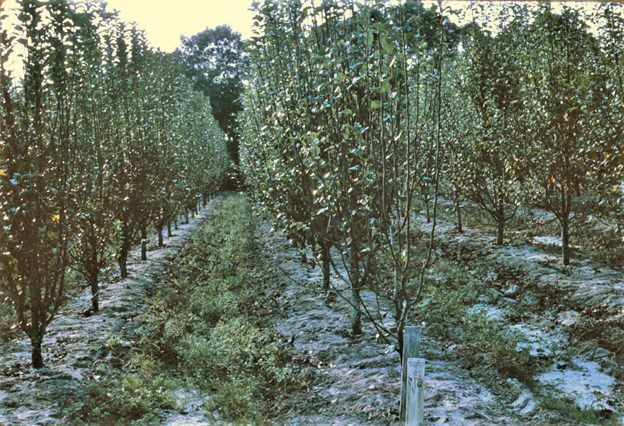
Credit: UF/IFAS

Credit: UF/IFAS
Harvesting and Storage
Pear fruit do not ripen properly on the tree. Fruit left on the tree soften irregularly and may manifest core softening and increased prevalence of stone cells, which gives the fruit a gritty texture. Harvest fruit when they begin to turn yellowish in color (Figure 7). Fruit can be stored at room temperature to fully ripen. Place fruit in a paper bag or newspaper to promote the release of ethylene gas and accelerate fruit ripening. Also, fruit may be stored before ripening in the refrigerator at 32°F to 40°F for one month without a significant loss in quality.

Credit: Chestnut Hill Nursery
Pest Control
Fire Blight
Fire blight (Erwinia amylovora) is a bacterial disease that enters flowers and young growth, causing blackening and a characteristic "shepherd's crook" to the growth. Older infections can move down the stem and cause black cankers on branches and trunks. Fire blight is generally a cool-weather disease, only occurring in the spring. Prune out blackened growth eight to ten inches below the affected area, and burn or dispose of the prunings. Pruning tools may spread the bacteria, so sterilizing pruning tools between cuts or between trees is recommended. Copper fungicide during bloom may be used to help control this disease. Follow label instructions for rates and reapplications.
Fungal Leaf Spot
Pear leaf spot (Fabraea maculata) can cause leaves to turn brown and fall off the tree on some varieties (Figure 8). Prevent this damage by applying a copper fungicide at 10-to-14-day intervals starting immediately after bloom. Follow label instructions for rates. Copper fungicides may cause fruit russeting. Selecting a variety that is resistant to leaf spot makes maintenance of pear trees much easier.

Credit: UF/IFAS
Botryosphaeria
Botryosphaeria canker is incited by a number of ligninolytic fungi, including B. dothidea, B. ribis, B. rhodina, and B. obtusa. They cause black cankers in the wood of pear and are especially prevalent on some Asian pears. There is no good chemical control. The recommendation is to maximize air flow through the canopy and avoid the formation of narrow crotch angles.
Scale Insects
Several scale insects may attack pear leaves, twigs, branches, and fruit. Apply horticultural oil sprays during the dormant season (mid-January is best) to control. Follow label instructions for rates.

Credit: Chestnut Hill Nursery
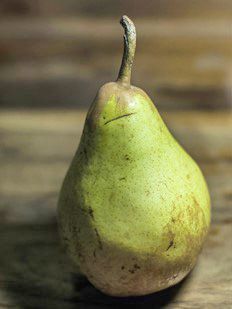
Credit: Plant Me Green Nursery
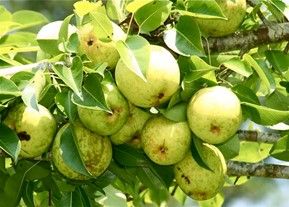
Credit: Chestnut Hill Nursery
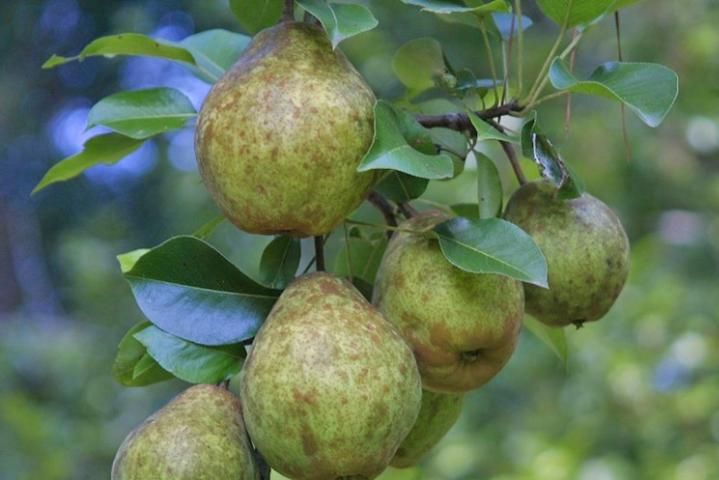
Credit: Chestnut Hill Nursery
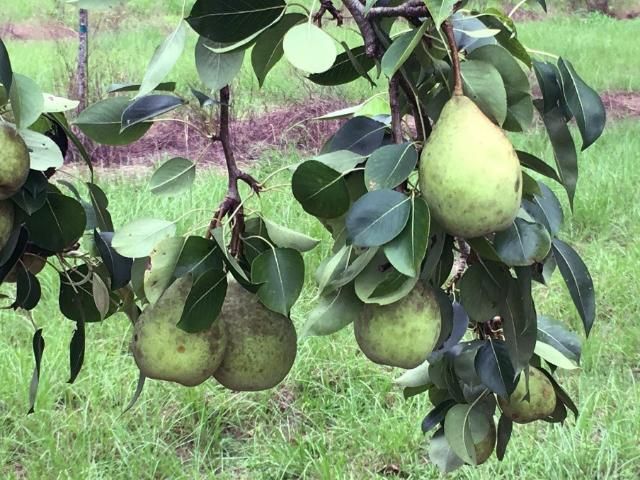
Credit: Chestnut Hill Nursery
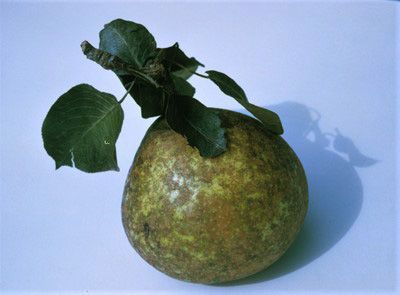
Credit: UF/IFAS
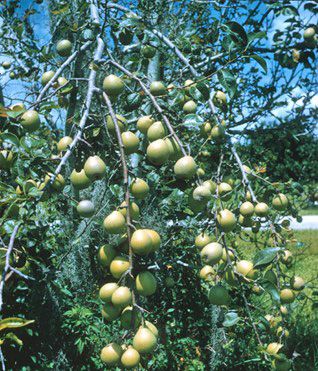
Credit: UF/IFAS
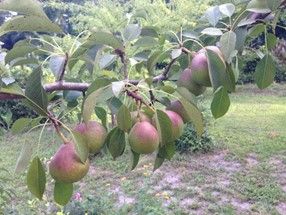
Credit: Just Fruits and Exotics
References
Andrews, C. P., and W. B. Sherman. 1979. "Hybrid Pear Cultivars for Florida." Proc. Fla. State Hort. Soc. 92:266–267.
Arnold, C. E., and W. B. Sherman. 1971. Growing Pears in Florida. Florida Cooperative Extension Service Circular 343.
"Chestnut Hill Nursery Catalog." n.d. https://chestnuthilltreefarm.com/product-category/fruit-oak-trees/pear-trees/. Accessed September 2023.
Krewer, G., and P. Bertrand. 2017. Home Garden Pears. Circular 742. Athens, GA: University of Georgia Extension.
Lipe, J. A., C. Lyons, and L. Stein. "Home Fruit Production—Pears." https://aggie-horticulture.tamu.edu/extension/homefruit/pear/pear.html. Accessed October 7, 2020.
Rosenberger, D., C. Watkins, M. Miranda-Sazo, C. Kahlke, M. Fargione, J. Nock, and A. Rugh. 2013. "Effects of Glyphosate on Apple Tree Health." Fruit Quarterly 21 (4): 23–27.
Williams, M. W., H. M. Couey, H. Moffitt, and D. L. Coyier. 1978. Pear Production. USDA Agriculture Handbook Number 526.